Tuesday 29 July 2008
Irked in Irkutsk
Heavily train-lagged (yes, the Trans-Siberian is so long and crosses so many time zones that this is possible) we are met at Irkutsk station by an odd-looking fellow called Vladimir. He mumbles something in English, cackles in a rather unnerving manner, adjusts his cap at a jaunty angle and shuffles off in the direction of the exit. We follow him across town in the fresh dawn light, over the glistening Angara river and through empty tree-lined streets, patrolled by stray dogs and bordered by solid wooden houses which looked like they’ve withstood the cruellest of winters.
Finally, our backs screaming for mercy, we make our destination: ‘The Museum of the Nature’ and, following a protracted entrance involving a bleary-eyed Babuska and a series of large rusty locks we enter, through the darkened galleries into a back office.
“Here we wait for a few hours until GBT [Great Baikal Trail] office is open”, Vladimir says, whilst cracking his teeth on a dry crust of bread. He offers it to us: “you want some breakfast?”
I opt for a wash instead and, in a vain attempt to remove four days of train grime from my torso I find myself using a bathtub in the back office that would spark a public health scare in Blighty; clearly it is more used to washing the grim tools of a taxidermist’s trade rather than a pallid Englishman.
Mad Vlad has disappeared upstairs, leaving us to ‘relax. We take in our new temporary surroundings: alone in a museum, with only a few stuffed animals for company. On one side of us a couple of bears stand frozen mid-battle, on another a majestic elk eyes up a shrunken otter.
Wandering into an adjacent room, Lara screams. Some of the creatures here it seems are still alive. There are rats in the room next door, and snakes, even a monkey. All crammed into tiny cages.
I texted my sister back in Blighty: “We’ve made it for Siberia, but you may not hear from us for a couple of weeks…”
9am, 29th July, Great Baikal Trail (GBT) office, Irkutsk
The volunteers assemble. Given this country’s history you might be forgiven for thinking something profound was taking place but the weapons assembled at this gathering, in a tiny couple of rooms off Chekhov St, were no more threatening than a few pickaxes and shovels - our tools for working on the trail over the next couple of weeks.
It’s utter chaos. The nine volunteers, tottering over under the weight of their backpacks, squeeze in between camping equipment and enormous sacks of onions, bread and other staple ingredients of the GBT diet. They rub their weary eyes, try to elicit answers from the panicking staff and attempt to get their visas registered.
Vladimir presides over all this, , shaking his head and muttering incomprehensively.
Finally our carriage (a creaking old van) arrives and we load up. Running late, our group leader, Nadya, finally arrives and somehow all 13 of us, and kit, squeeze in.
Half an hour later, plunging along the bumpy roads towards a waiting boat, Nadya introduces herself and the project. “Now”, she beems, “have I told you about the vipers and the dangerous ticks…?
12pm, 29th July, the campsite, somewhere near Lystvyanka, Lake Baikal
Finally, we have a home for the next two weeks, a dirty little tent we can call our own. We had to hike through the taiga in order to retrieve it from another GBT campsite, taking it down and emptying it of the previous occupants discarded rubbish.
Back at our campsite, nestled under birch and pine trees next to the shimmering lake we gingerly reassemble our new homes amidst the long grass, Nadya’s warnings regarding the local wildlife still ringing in our ears.
The mosquitoes are hungry; the sun is baking; and we haven’t had a bite to eat since what feels like Moscow. We were aware that conditions would be testing but what followed would have a reality television executive drooling. You couldn’t make it up. Yes, this is Survivor (Siberia)...
Read more...
Monday 28 July 2008
A typical Trans-Siberian stop
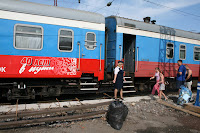 Like our fellow passengers we spent our time on board the Trans-Siberian sleeping, playing chess, reading, paying visits to the samovar for hot drinks and more sleeping (train travel always seems to have a pleasantly soporific effect).
Like our fellow passengers we spent our time on board the Trans-Siberian sleeping, playing chess, reading, paying visits to the samovar for hot drinks and more sleeping (train travel always seems to have a pleasantly soporific effect).This monotony was only broken by the handful of stops our train made every day which allowed passengers to alight and stretch their legs. The following describes a typical stop.
The toilets have been closed for the last ten minutes, the passengers mill about in the corridor, expectant fags at the ready, the train starts to slow: there must be a stop coming up
Heaving to a shuddering halt, the expectant passengers impatiently wait for the provodnitsa to open the heavy steel door and haul down the steps. A physically-challenging and rather complex process, this often seems to require the help of one of the many bare-chested men who always seem to be on hanging around.
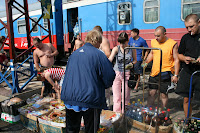 Outside on the platform a gaggle of Babuskas (is that the collective noun?) line up their improvised stalls, ready to hawk their wares - packets of noodles and biscuits, along with more homegrown treats such as cabbage dumplings, boiled potatoes and smoked fish.
Outside on the platform a gaggle of Babuskas (is that the collective noun?) line up their improvised stalls, ready to hawk their wares - packets of noodles and biscuits, along with more homegrown treats such as cabbage dumplings, boiled potatoes and smoked fish.The passengers gingerly step off the train, heaving themselves down off the high steps, dodging puddles, piles of ballast and the broken glass of beer bottles to make the ‘platform’, often little more than a rough strip of concrete, or even bare ground, with great waterlogged holes in it
The flock over to the babuskas, waving roubles and plastic bags in a frenzy of hunting and gathering.
The little shop set back from the platform soon attracts their attention: time to stock up on booze and fags. Passengers crowd around the tiny window, always seemingly built with your average Oompa-Lumpa, rather than a human, in mind.
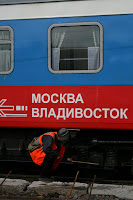 Back by the train, a leathery chap saunters along the platform banging the wheels and undercarriages as he goes. This is no act of state-sponsored vandalism, rather he plays a key and rather reassuring role, searching the wheels for cracks and checking the integrity of our moving home.
Back by the train, a leathery chap saunters along the platform banging the wheels and undercarriages as he goes. This is no act of state-sponsored vandalism, rather he plays a key and rather reassuring role, searching the wheels for cracks and checking the integrity of our moving home.He is followed by a weatherbeaten, broad lady, who jams a metal rod through a crack in the concrete platform, heaves on a dilapidated old valve and feeds water somewhere into the bowels of the carriage.
In the background the tannoy crackles and enormous freight trains roll by, dragging rusty wagons, past stray dogs, departing families and railway workers taking a break in the shade of a advertising hoarding.
Over on the next platform a train rolls up, carrying armoured personal carriers. From every window hordes of brawny soldiers crane their necks out, their eyes screwed up against the sun, on the lookout for more beer and fags.
Back on our side, other soldiers, off-duty and travelling amongst us strut about in their sandals and tight polyester shorts, swigging warm lager and sunning their bare, heavily-tattooed chests.
Suddenly the provodnitsa bellows: “All aboard, get back on now or spend the next night in the middle of nowhere.”
Like chicks to a mother hen, the passengers duly oblige and scurry back to their stuffy little cabins, waiting for the train to get moving and the air con to once more heave back into life.
Oh well, only another four hours of eating and sleeping until the next stop...
Read more...
Sunday 27 July 2008
Russian dolls
 In a country where women are still expected to behave in a ‘traditional’ manner, I have broken many rules of etiquette. I have carried heavy bags when walking with a man; I have been assertive in public; opened doors; and paid my way in social situations. Who knows what scorn I have received in doing so. But there is one aspect of Russian life that makes me relieved to be a woman - vodka drinking. Women are excused after a couple whereas men are expected to finish the bottle.
In a country where women are still expected to behave in a ‘traditional’ manner, I have broken many rules of etiquette. I have carried heavy bags when walking with a man; I have been assertive in public; opened doors; and paid my way in social situations. Who knows what scorn I have received in doing so. But there is one aspect of Russian life that makes me relieved to be a woman - vodka drinking. Women are excused after a couple whereas men are expected to finish the bottle.As soon as we boarded the Trans-Siberian Railway from Moscow to Irkutsk we were offered a drink by Alexei - a drunk, shirtless, built Russian with a scorpion tattoo on his chest. After repeated invites, we sat down to look at the video clips on his phone. Following a Full Metal Jacket episode of bathroom cleaning set to ‘In Da House’ we realised that him and his mate were Russian soldiers. So it would appear were many of the men on our train including Serge, the army instructor in our berth taking his daughter to Vladivostok to see his mother. Seemed like a nice bloke. You wouldn’t imagine that he mended machine guns for a living.
So for 36 hours Tom was avoiding Alexei’s various invitations to drink: the flick on the neck, the body builder pumping motions and the range of masculine grunts. Tom admitted feeling like a prisoner, only happily roaming the carriages once we saw Alexei being put to bed by the carriage attendant at three in the afternoon. I have another friend who has feigned hepatitis in order to avoid similar macho vodka drinking sessions. My refusals were however taken more readily. Sometimes it pays to be a woman in Siberia.
Read more...
Friday 25 July 2008
Hello Lenin
Lenin’s dressed in his Sunday best; dark suit, spotty tie, but unlike a trip to your Auntie Hilda’s there’s something rather bizarre, even grotesque, about visiting many Soviet’s favourite uncle. Inside his dark chamber, fiercely protected by young, spotty automaton guards, he lies in a glass casket. His skin is pale and waxy, like a once-loved Russian doll cast aside by a little owner who has long since grown up.
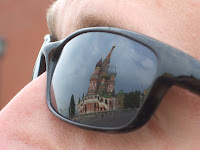 There’s plenty of barmy theories about this diverting freakshow; some even question whether this curious cadavar is the real Mr Ulyanov. One thing’s for certain though: L’Oreal or the Body Shop could learn a trick or two from the brilliant scientific minds who have kept him nicely pickled here for nigh-on eighty years.
There’s plenty of barmy theories about this diverting freakshow; some even question whether this curious cadavar is the real Mr Ulyanov. One thing’s for certain though: L’Oreal or the Body Shop could learn a trick or two from the brilliant scientific minds who have kept him nicely pickled here for nigh-on eighty years.Or maybe he’s kept here in order to prevent him turning in his grave. Given the amount of change that has taken place here in Moscow the earth would be seriously disturbed.
Indeed the city and the habits of its inhabitants has changed so radically that Lenin’s large red ziggarat, poking out onto the cobbles of Red Square in a manner which might lead Prince Charles to call it ‘a carbuncle’, has become an embarrassment to some, yet one that they keep deferring what to do with.
Read more...
How to….survive in Russia
 ‘Russia, is a miserable country. Why are you going there?’ was the question posed by many Finns upon our departure. For me it was the tales of painful bureaucracy that I was concerned about. Should you show your real passport or a copy upon request from bobbies on the beat? How could I ensure I had the correct stamp on my migration card? And how the hell were we going to understand Cyrillic?
‘Russia, is a miserable country. Why are you going there?’ was the question posed by many Finns upon our departure. For me it was the tales of painful bureaucracy that I was concerned about. Should you show your real passport or a copy upon request from bobbies on the beat? How could I ensure I had the correct stamp on my migration card? And how the hell were we going to understand Cyrillic?Russia is a real life computer adventure game. You have to collect clues, decode signs and gather special items to allow you through to the next stage. For anyone planning to come to Russia overland, here are some hints and cheats to help you score extra points.
After considerable confusion and shunting between the provodniks (carriage attendants) and the Finnish conductor over our second class tickets being in first class carriage we were moved to the VIP disabled berth with oodles more room than the Scottish sleeper. Our new provodnik gave us migration cards and customs forms to fill in. Fill the migration card in in correspondence with your visa. Part A is collected when the guards board the train, Part B returned. You need to keep Part B to get out of the country. For customs it’s the usual stuff to declare: booze, fags, drugs, guns, radioactive substances etc. You also have to declare money (travellers cheques and currency) over $10,000 USD. The customs officer took one look at our empty forms and left us alone with a dissatisfied grunt. Within three days of arrival in Russia you also need to register your visa.
Travelling on the Moscow underground requires a different set of deciphering skills altogether. The big red ‘M’ means underground station. You can buy a ten journey pass by holding up ten fingers to the cashier and handing over 150 roubles (£3). Be aware that there are two types of entry barrier on the Moscow underground. One has a bar across it. To overcome this, stamp your ticket in and out of the slot and go through. The other has no bar across it. To get through this you need to touch your ticket against the yellow blob. It otherwise becomes a booby trap and you get walloped by a waist-high barrier on either side.
The tube station names are all in code (Cyrillic). The tube map is in both Cyrillic and English. We found that by matching the name to the code and then remembering the first few symbols we could generally find the right platform. The platforms themselves don’t have signs, so you need to remember how many stops you need to go and count them off on route. So no scope for falling asleep after a big night and waking up in the equivalent of Epping.
Code also causes hunger. Having proudly arrived at the tube station of our choice and navigated through a series of Cyrillic street names we were at a loss to find the Yolki Polki or Rossikye Bistro that were churning our gastric juices. After many attempts at mispronunciation with a copper we found the restaurant, sign in Cyrillic. Inside was the first time in over a decade that I have felt like a completely flummoxed foreigner. The whole damn menu was in Cyrillic and the wait staff were boggling at us like fish in a bowl. I resorted to pointing at other diners tables and we were then delivered meat dumplings (пельмени) with sour cream (сметана) and pancakes stuffed with ground meat. We hung on to the receipts and pointed at them the next time we ate out.
Aside from the encoded street names, walking around Moscow isn’t exactly easy or pleasant. Here the car is king and every man is a king. Our local tube station
 is on a sixteen lane ‘boulevard’. You are given exactly 42 seconds to cross the road. The local freesheet reports that half of the people who die in road traffic accidents are pedestrians, in stark comparison to 14% in Western Europe. So in answer to this, Moscow city authorities are going to get rid of pedestrian crossings in favour of subways, raise sleeping policemen along the road when the lights turn red and teach children road laws. Naughty, ignorant pedestrians walking all over the place. Much better to hide us away underground so we don’t get in the way of the cars, we don’t want to see daylight anyway. Cart; horse; bolted?
is on a sixteen lane ‘boulevard’. You are given exactly 42 seconds to cross the road. The local freesheet reports that half of the people who die in road traffic accidents are pedestrians, in stark comparison to 14% in Western Europe. So in answer to this, Moscow city authorities are going to get rid of pedestrian crossings in favour of subways, raise sleeping policemen along the road when the lights turn red and teach children road laws. Naughty, ignorant pedestrians walking all over the place. Much better to hide us away underground so we don’t get in the way of the cars, we don’t want to see daylight anyway. Cart; horse; bolted?And a final note for those for whom fashion is survival. Less is more in Moscow. Especially in gaudy colours and patterns and as much bling as you can get away with at 11 in the morning. Nude pop socks worn in sandals or stilettos with a skirt, dress or shorts are this season’s must. Russian brides dot com ‘r us.
Read more...
Monday 21 July 2008
Into Russia (with parsnips)
We were leaving Finland, with its endless trees and lakes, double windows and ladders on roofs, markets selling berries and peas and kids swigging strong cider in parks, and now heading east to travel the length of its enormous neighbour - Russia.
The Moscow sleeper passes through St Petersburg, tracing the footsteps of Vladimir Illich Ulanov, AKA Lenin, and like everyone’s favourite bearded revolutionary , I enter Russia with excitement mixed with no small measure of trepidation.
This is partly due to my last visit to Russia (a rather miserable affair: cold; wet; the street in which the ‘hotel’ stood was in the process of being demolished; the staff refused to believe we had a vacancy) but also perhaps thanks to the reputation which often precedes this enormous nation.
Ivan the Terrible…the Politburo…food queues…goose-stepping red guards in front of the Kremlin…nuclear Armageddon….the cold war…cabbage soup…
This is a fascinating time to visit Russia; have all these negative images finally been buried? Or does Russia’s new-found wealth (thanks to its enormous oil and gas reserves) pose new concerns to the rest of the world. A resurgent Russia, strong, powerful and keen to flex its muscles.
The mind boggles at how much change people must have seen over the last 15 years or so. Have they really managed to shake off the bad old ways of the past whilst not sacrificing the many wonderful and unique elements of their culture which enrich the rest of the world?
We wait to find out. In the meantime we have certainly noticed that we are entering a very different place from ‘the West’: the Cyrillic alphabet poses new language challenges to us (does this button set off the emergency alarm or flush the toilet?) and the guards’ hats just seem to get better the further east we head - you could eat a Sunday Roast off the top of them, complete with pasternaks.
Read more...
Sunday 20 July 2008
Suomi in extremis
 Finns live in a world of extremes and consequently like a lot of dark, and a lot of light, things:
Finns live in a world of extremes and consequently like a lot of dark, and a lot of light, things:Dark things
- Reikaleipa (circular unleavened rye bread traditionally dried on poles across the ceiling. Finns have developed special teeth to process this igneous delicacy).
- Coffee (Finns are the caffeine kings of Europe, apparently consuming 14kg of coffee a year. Lonely Planet equates this to, on average, 9 cups a day, but my guess is that it is simply the strength of the stuff they drink that requires so much bean).
- Salmiakki (salt liquorice. Tastes as disgusting as it sounds. But Finns love it, even in ice cream and vodka).
- Mammi (special cold, sweet rye porridge. Only eaten at Easter for a “treat”).
- Hair dye (gone are the flaxen Scandinavian locks in favour of various shades of black hair dye. Usually set with black jeans, black t-shirt and black accessories).
- Heavy music (Iron Maiden were in town on Friday. Now half the population of Helsinki are sporting tour t-shirts. Home-grown favourites include CMX and Maj Karma. This is the land where Lordi is considered light pop).
Light things
- Beer (regardless of which beer you buy they all look and taste like lager. A nation of binge drinkers without a palette).
- Midnight sun (it really doesn’t set. This screws up the body clock and makes dinner at 2:30am seem acceptable).
- Snow (and lots of it. White and pure. Used for cross-country skiing and rolling post-sauna).
- Cheese (it’s either emmental or gouda in varying strengths. All anaemic and bland).
- Villi (a stringy plain yoghurt that behaves like glue).
- Potatoes (they love them. And talk about them, a lot. The peruna is a staple of the Finnish diet).
Of the above I only enjoy a few outside the context of novelty. I don’t enjoy the extremes of hot and cold between sauna and lake , and found even the Scottish winters too long and dark. So maybe the English side of my heritage does allow for some degree of grey.
Read more...
Thursday 17 July 2008
How to …build a sauna
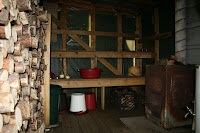 Four years later then, on our return to Bruce and Anna’s wonderful forest hideout near Rovaniemi, it seemed appropriate and indeed sensible, to perhaps try and construct a new sauna.
Four years later then, on our return to Bruce and Anna’s wonderful forest hideout near Rovaniemi, it seemed appropriate and indeed sensible, to perhaps try and construct a new sauna.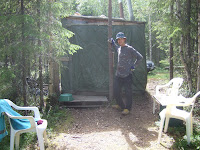 Libraries which might like to provide students with a nice hot break from their studies or supermarkets could offer tired shoppers a nice quick relieving sweat in between buying the weekly groceries…
Libraries which might like to provide students with a nice hot break from their studies or supermarkets could offer tired shoppers a nice quick relieving sweat in between buying the weekly groceries…1. Find a site, preferably a nice, peaceful heavily-forested location next to a lake (the colder, the better).
2. Buy a sauna with log cabin to place it in. This being Scandinavia, you can easily find a ready-built kit. You just need a chum with a tractor to cart the lot to your site.
3. Get some more mates round to heave the heavy pine timbers into position.
4. Sit back and admire work, deciding you‘ll get the builders round to finish the job.
 Add in endless swarms of massive, ill-mannered, blood-sucking mosquitoes, pour in lashings of warm lager and mix with an unusually hot day. Add in a liberal dash of an open attitude to group nudity and garnish with a Makkaraputki (‘sausage pipe’).
Add in endless swarms of massive, ill-mannered, blood-sucking mosquitoes, pour in lashings of warm lager and mix with an unusually hot day. Add in a liberal dash of an open attitude to group nudity and garnish with a Makkaraputki (‘sausage pipe’).Serve it all up, before the ice on the lake starts to melt, at a birthday party for fellow scientists and climatologists (‘Antarctica’s nice this time of the year…’)
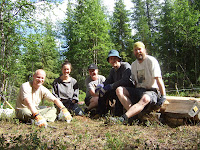
Read more...
Monday 14 July 2008
Ooop North
 What were we thinking of when we left the throbbing, hedonistic delights of Tammerfest way back down south just 20 hours ago? Tampere had heavy metal and lager; the North Cape has an extortionate entry fee and an irritating Dutch family who insisted on erecting their big top-sized tent right next to us in this empty, windswept place.
What were we thinking of when we left the throbbing, hedonistic delights of Tammerfest way back down south just 20 hours ago? Tampere had heavy metal and lager; the North Cape has an extortionate entry fee and an irritating Dutch family who insisted on erecting their big top-sized tent right next to us in this empty, windswept place.We made the 900 mile journey through the night. Or what there was of it. The sun never really sets this far north in July and last night it just merely skimmed the horizon somewhere on the road between Kemi and Oulu.
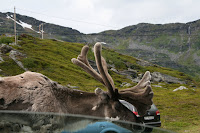
Sustained by Rammstein and rye bread we sped along empty roads with only road trains and the odd reindeer to trouble us, the latter blissfully unaware of the numerous unpleasant plans the locals have in store for them (reindeer kebab, anyone?).
Our Nokia Sat Nav made little of the huge deserted spaces we passed through - a straight black line through an endless block of green, like an early Nintendo game.
Crossing the border into Norway brought little immediate difference, other than the odd green number plate and the appearance of strange letters with funny lines through them. Once we actually stopped and ventured into a store it was a different matter however, with a hike in prices which would make a Chelsea footballer swoon.
Living in the country which regularly tops the UN quality of life index clearly comes at a cost.
Fourteen hours in to our journey the landscape began to change as we left the thickly-forested flatlands behind. The road twisted through gentle fells before winding down into Alva - our first sight of a fjord. In the distance mountains rose out of the mist, some still holding pockets of snow.
Out of Alta we climbed up onto high a plateau, where flimsy wooden shacks hug the ground and elderly Sami hunched by the roadside selling inumberable reindeer-related trinkets to tourists on the long road up to the Cape.
 Beyond the mountains, we skirted the edges of huge fjords, through sparsely scattered fishing villages, their nets and catches drying in the brilliant sunshine.
Beyond the mountains, we skirted the edges of huge fjords, through sparsely scattered fishing villages, their nets and catches drying in the brilliant sunshine.Finally the tunnel to the island holding Europe’s most northerly point appeared ahead of us: an impressive seven kilometres of engineering (and boy did we have to pay for every metre at the toll station at the end of it).
Into a spectacularly craggy landscape, where the road never ran straight and the land started to run out. And so did our patience with the money-grabbers in our way, refusing as we did to pay the £60 fee to enter a car park marking the ‘official’ North Cape.
Rather we opted for the more thrifty and healthy option of a brisk 12 mile yomp across the rocky landscape to the farthest northerly point - technically farther north than the official one.
Flushed with this moral victory we celebrated with a warm Finnish lager before making a break for the border and a land where some things at least, are free.

Read more...
Saturday 12 July 2008
Fishing Finns
 Sitting by the lake shore under a silver birch the moomin family had pike for dinner.
Sitting by the lake shore under a silver birch the moomin family had pike for dinner. Moomin mama gasped.
Moomin mama gasped.  Moomin son smoked the fish over sawdust and alder.
Moomin son smoked the fish over sawdust and alder.  Meiskis meiskis!
Meiskis meiskis! Read more...
Thursday 10 July 2008
A Scandinavian booze cruise
No; it was just another ferry trip across the Baltic.
At the first ray of sunshine the fellow had ripped off his t-shirt, exposing his expansive Viking chest but, it being Scandinavia, he didn’t stop there. I sunk into my fleece and pondered the stereotypes being confirmed around me on this 11 hour ride between Stockholm and the port of Turku, in southern Finland.
It was glorious weather; the sea was as flat as a pancake. A fine day for getting gloriously drunk on the duty free booze. Lapin Kulta for the gents, gin and tonic in a can for the ladies. And what better place to do it; complete with disco, casino and more slot machines a-plenty (plus of course the obligatory sauna) the Isabella was Las Vegas-on-sea.
To complement the beer-swilling muscle men there was a more than healthy contingent of goths, waif-like and pallid with multiple piercings, black-dyed hair and drab clothing promising various doom-laden futures. This was hardly surprising for a ship heading for Finland, but I couldn’t help noticing how normal their parents looked.
Regardless of how many lagers they’d swilled, no-one could fail to be impressed by the scenery: sliding out of the picture-perfect centre of Stockholm we passed between hundreds of forested islands lining the route to sea. As we left Sweden behind and entered the Baltic we soon reached Marie Hamn the tiny ‘capital’ of the Aland islands, a collection of hundreds of low-lying, rocky islands lying in the Baltic between Sweden and Finland.
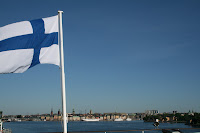 An interesting quirk of international relations the islands autonomous status is a result of the shifting power struggles between Sweden, Finland and their great neighbour to the east, Russia - all of which have left their influence.
An interesting quirk of international relations the islands autonomous status is a result of the shifting power struggles between Sweden, Finland and their great neighbour to the east, Russia - all of which have left their influence. Back on deck, after several hours negotiating the narrow passages between the islands, the Isabella headed once more out to sea. The karaoke booming out from the disco was reaching execrable proportions. Mr Carlsberg wasn’t listening though - he had been thrown out of the bar and sat groaning at a bench outside; with his head in his hands his faithful son put a consoling arm around his shoulder. Hangovers are always worse at sea.
Typical passengers:
MS Isabelle: blonde wife, bearded husband, gaggle of flaxen-haired kids sunbathing
VR (Finnish railways, Turku harbour-Tampere): passengers laden down with duty-free booze, dragging their booty along corriders and stuffing it in every available space (including in prams)
Read more...
Tuesday 8 July 2008
Letting the train take the strain
I’ve always been excited by continental railway stations; the range of destinations on offer. Where do you fancy going today: Paris, Amsterdam, Berlin or Munich today? Possibilities...
Even though I’ve spent the last two days solid on trains (nine, so far…) in order to reach Stockholm it’s
 been the most relaxing and stress-free experience. From the minute I arrived at the wonderfully-restored St Pancras station I’ve been treated to the best of trains: slick, super-fast and supremely comfortable - a far cry from the regular experiences of the exasperated British commuter.
been the most relaxing and stress-free experience. From the minute I arrived at the wonderfully-restored St Pancras station I’ve been treated to the best of trains: slick, super-fast and supremely comfortable - a far cry from the regular experiences of the exasperated British commuter.I’ve sped through seven countries, going under the English Channel, over the Rhine, onto a ferry (whilst on the train) over the Baltic Sea between Germany and Denmark, and across the monumental 5 mile long Oresund bridge between Denmark and Sweden.
Moreover, unlike with flying I’ve been able to notice and appreciate the subtle changes along the way.
Having travelled in terms of latitude the equivalent of Sheffield to Shetland I’ve witnessed the changes in languages, accents, food, and even dress (I can safely confirm the socks and sandals phenomenon really does take off at the German border).

Take my first day: as the train headed east out of Brussels the tannoy broadcast announcements in no less than four languages, reflecting the very mixed cultural history of this particular corner or Europe, where borders have become increasingly insignificant.
Or the next day where, as I headed out of Malmo, it suddenly felt as if this was where mankind’s presence in Europe starts to wain, as we headed into a seemingly endless vista of trees, lakes and very few stations.
You may gaze down upon this from a plane but you can never feel it as you would if you travel through it.
Pictures: Cologne cathedral, and train on Baltic ferry
Typical train passengers:
Eurostar (UJ-Belgium): suit, tie, Dell and Café Nero
Thalys (Belgium): muddy festival goer, exuberant or asleep, multiple peircings, pink wellies, Quechua tent and sleeping bag
Deutsche Bahn (Germany): middle-aged tubby junker, ruddy in cheeks and surly in manner, pink shirt and clashing chinos
DSB (Denmark): Boisterous party of scouts, massive backpacks and trunks, matching neckerchiefs and obscure badges. Interesting line in campfire songs
SJ (Sweden): Monosyllabic housewife, knitting in hand
Read more...
Thursday 3 July 2008
A tribute to selfless generosity
 and great company. Especially welcome in a city where a bread roll costs £1.20! If you get a change to see a play by Nina Larissa Bassett, do. Both mother and daughter are working hard to retain the fading liberalism of Denmark.
and great company. Especially welcome in a city where a bread roll costs £1.20! If you get a change to see a play by Nina Larissa Bassett, do. Both mother and daughter are working hard to retain the fading liberalism of Denmark.  In Hamburg my former flatmate's brother, Florian Oediger, gave up a day of only his second free weekend since completing his thesis to show me the Hanseatic sights of Hamburg and help me blag my way into the public screening of the European Championship final. I was an international sports journalist for the evening. I'm just sorry that your team didn't win Florian.
In Hamburg my former flatmate's brother, Florian Oediger, gave up a day of only his second free weekend since completing his thesis to show me the Hanseatic sights of Hamburg and help me blag my way into the public screening of the European Championship final. I was an international sports journalist for the evening. I'm just sorry that your team didn't win Florian. Read more...
How to...get to Finland without flying
Travelling through Europe is a breeze, with the invaluable help of the Man in Seat 61. Here's how I ended up in an internet cafe called Matrix surrounded by Swedes playing virtual role play games:
 London to Brussels on the Eurostar, arriving in Brussels Midi station. Brussels Midi to Koeln Hbf (Cologne train station). Tickets can be half price if you buy on line in advance at http://www.b-rail.be/ (you have to register to use the site). You will not be given a ticket, only a booking reference number and collection code. Write these down and take them with you. When you get to Brussels go to the ticket collection machines near the 'Ing' meeting point. Type in the codes and your ticket pops out.
London to Brussels on the Eurostar, arriving in Brussels Midi station. Brussels Midi to Koeln Hbf (Cologne train station). Tickets can be half price if you buy on line in advance at http://www.b-rail.be/ (you have to register to use the site). You will not be given a ticket, only a booking reference number and collection code. Write these down and take them with you. When you get to Brussels go to the ticket collection machines near the 'Ing' meeting point. Type in the codes and your ticket pops out.In Cologne I stayed at: http://www.hostel-cologne.de/. Ask for a quiet room (not on the station side) and not on floor 3 - it stinks! If you don't stay in Köln, the cathedral is right outside the train station. Directly in front. One minute away. And it's free to go in. So if you have time between trains you can just nip in. For a taste of the local brew, there is a good pub (Brauhaus Früh am Dom) nearby that serves the famous Kölsch.
To buy cheaper tickets in advance from Köln to Hamburg (or anywhere in Germany or to Copenhagen or Stockholm) go to http://www.bahn.de/ (you can change the language top right). Again, you'll have to register. You get an e-ticket to print out. Take this with you. When your ticket is checked on the train you'll also need to present the card you bought the tickets with.
To buy a ticket in advance from Copenhagen to Stockholm is tricky as you can only collect them from Copenhagen airport. So I just bought mine at Copenhagen station on arrival from Hamburg.

Take the Viking Line ferry from Stockholm to Turku, Finland. There are two sailings each day. One in the day (going through the archipelago is beautiful) and one at night (be prepared to party). I'm on the 07:45 tomorrow. You can buy a ticket as a passenger when you turn up (€17.50).
European public transport is clean, spacious and punctual. I have watched the United Kingdom merge into central Europe and turn into Scandinavia. Travelling overland has been cathartic, creating the space between crazy London life and the trip of a lifetime.
Read more...
Wednesday 2 July 2008
How to...pay for the whole trip!
However, the following tips might be useful if you are pondering just what might be the best option in terms of paying for items.
1) Spread your money across different forms of payment, for reasons of both personal security and ease of paying for goods and services. It helps to always have a back-up option - 'greenbacks' (US dollars) for example are known to be popular in many parts of the world.
2) Investigate which means of payment is most used in countries payment before you leave (obvious, really). For instance we have been advised that ATMs/cashpoints in Japan are surprisingly scarce.
3) Take travellers cheques. For the parts of the world we are visiting we have been advised to purchase these in US Dollar travellers cheques rather than those in UK Pounds.
4) Try and take a little bit of the local currency if you can before you get there. Friends can give you any spare change they might have and this helps if you have to use public transport etc immediately upon your arrival.
A wee anecdote about procuring the requisite funds:I chose to support my local post office. Having left London and decamped to the country for a week I had the pleasant experience of catching up with old friends in that most glorious of institutions - the village post office.
The patience of our postmistress, the lovely Alice, was severely tested by the various obscure requests of yours truly combined with the confusing instructions from her colleagues at Post Office central. For some bizarre reason, at their insistence, the chip and PIN machine was eschewed in favour of an ancient old imprint machine - a museum piece which clearly hadn't seen action since Suez.
I was reaching for the quill and parchment when Alice finally managed to wipe all the dust off and produce an acceptable carbon copy. Still, it worked and it was alot more fun than the usual joyless visit to a miserable high street bank. If only Gordon B appreciated that.
Cashier number three please!
Read more...



